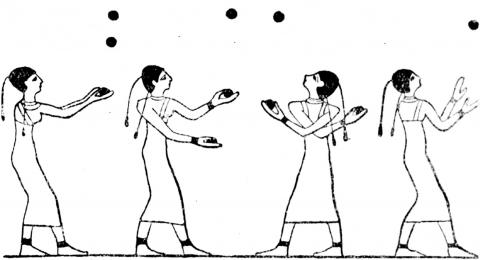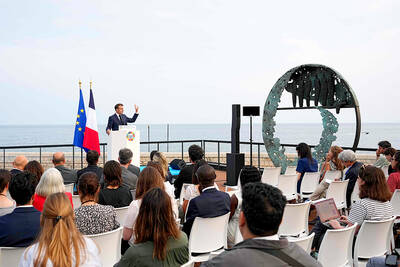Chinese practice
博而不精
all-round knowledge; jack of all trades

Photo: Wikimedia Commons
照片:維基共享資源
(bo2 er2 bu4 jing1)
Steeple(尖頂)是一種塔狀建築結構,常見於教堂屋頂上。Steeplejack是攀至煙囪、尖塔等高處以進行修繕的高空作業工人。Lumber是由圓木裁切成形可直接使用之木材。Lumberjack則是砍伐樹木並裁切木材的工人。
Steeplejack和lumberjack的字尾jack是源於過去很常見的男子名,用來泛稱一般的男子,尤其是具有某種技能的匠人。「Jack of all trades」指的是某人擅長的事很多,但沒有特別專精某一種技能。此俗語全句為「A jack of all trades is a master of none, but oftentimes better than a master of one」(會很多種技能的人不會是大師,但通常比專精某一項的大師好),而頗有贊許之意。現今較常用的說法是「A jack of all trades and a master of none」,最常以簡化的「jack of all trades」出現,且一般作貶義用,意指某人會做的事很多,但沒有一項是專精的。「Jack of all trades」這片語可應用於任何領域,不限於匠人及勞工。
有趣的是,一個類似的用語「Johannes factotum」—源自拉丁語,英語為Johnny do-it-all(包辦一切的強尼),也有這樣的貶義。此語為已知最早的對莎士比亞作品的記載,是一五九二年當時著名的詩人及劇作家羅伯特‧格林批評莎士比亞身兼演員與劇作家,一定寫不出好作品。莎翁已被後世公認為最偉大的英語作家,此句批評顯示一個人的眼光有可能多麼失準。
成語「博而不精」可說也有等同的意義。此語出自《後漢書》〈馬融列傳上〉。馬融(西元七九~一六六年)在朝廷任官,並為東漢著名經學家。〈馬融列傳上〉記載,馬融曾想為《左氏春秋》作注疏,但後來讀到精於左傳的經學家賈逵(西元三○~一○一年)及宦官鄭眾(生年不詳,卒於西元一○七年)的左傳注疏,便說「賈君精而不博,鄭君博而不精。既精既博,吾何加焉!」(賈逵的左傳注專精而不廣博,鄭眾的左傳注廣博而不專精。現已同時有專精與廣博兩種版本,便不需我再添上一筆了!)
(台北時報編譯林俐凱譯)
許多企業希望教育系統能夠培養專精於某領域的專才,而非博而不精的通才。
(Many businesses want the education system to produce specialists in certain fields, not generalists with no specific expertise.)
這篇文章觸及了許多議題,但博而不精,很多地方只是草草帶過。
(This article touches upon all kinds of subjects, but none in any real depth. In many places it just glosses over them.)
英文練習
jack of all trades, master of none
A steeple is a tower-like structure often found on churches. A steeplejack was a person who climbed tall structures like chimneys and steeples to carry out repairs. Lumber means logs that have been cut for use. A lumberjack was a person who felled trees and cut them into lumber.
The suffix “jack” derives from the use of Jack, once a very common man’s name, to refer to a man in general, and particularly one with a trade. A “jack of all trades” is a person who is good at many things, while not being particularly specialist at any one. The full phrase was once “A jack of all trades is a master of none, but oftentimes better than a master of one,” and as such was quite complimentary. The more common formulation nowadays is “A jack of all trades and a master of none,” most often shortened to simply “jack of all trades,” and generally used in a derogatory sense, meaning that the person in question is able to do many things, but is not particularly good at anything. Nowadays, jack of all trades can be used in any field, and is not confined just to trades and labor work.
Interestingly, a similar term — derived from Latin — was “Johannes factotum” (Johnny do-it-all), which carried the same pejorative meaning that jack of all trades does today. It was a term directed at William Shakespeare in the first known reference, in 1592, to the work of the man many consider the greatest English language writer of all time, for having the audacity to attempt writing plays in addition to acting. The attack was written by a well-known contemporary poet and playwright named Robert Greene. How wrong a person can be.
One possible Chinese equivalent — 博而不精 — comes from the Biography of Ma Rong in the ancient text Book of the Later Han. Ma Rong (79–166AD) was a government official and a renowned Confucianist scholar in the Eastern Han dynasty. In the Biography it is said that Ma was researching the Zuo Zhuan to write a commentary and explanation of the text, but after reading the works of two men, Jia Kui (30-101) — a Confucian scholar and an expert in the Zuo Zhuan — and the powerful eunuch Zheng Zhong (d. 107), he wrote: “Jia has a profound knowledge, (精而不博) while Zheng’s knowledge is broader, yet not as deep (博而不精). Between the combined breadth and depth of their contribution, what more can I add?”
(Paul Cooper, Taipei Times)
I don’t think you could call him an authority on this matter. It seems to me he has always been a bit of a jack of all trades.
(我覺得你不該稱他為這方面的權威,對我來說他總顯得有些樣樣通,樣樣鬆。)
He’s a decent striker, and he’s good in midfield, but he’s too much of a jack of all trades to ever be a world class footballer.
(他是個像樣的前鋒,中場也很行,但是他太雜而不精,不可能會成為世界級的足球員。)

William I of Prussia, a passionate painter, often autographed his works with “tormentis pinxit” — “painted in pain” — as a nod to his struggles with gout. Other historical figures like King Henry VIII of England and Benjamin Franklin also suffered from this “disease of kings,” which was common among people indulging in luxurious diets. Gout is primarily caused by high levels of uric acid in the body. Uric acid forms as the body breaks down purines, which are found in foods like red meat and seafood. Normally, the kidneys filter out uric acid. However, if the body produces

The UN Ocean Conference wrapped up in Nice, France on Friday last week with world leaders taking major steps toward marine protection and vowing a showdown when nations meet to negotiate rules for deep-sea mining next month. But a lack of funding pledges and the total omission of fossil fuels disappointed some observers. The summit was just the third — and largest yet — dedicated entirely to what the United Nations calls an “emergency” in the world’s oceans. The High Seas Treaty, or Global Ocean Treaty, is also known as the Agreement under the United Nations Convention on the Law

A: The National Palace Museum (NPM) has launched an exhibition, titled “From Impressionism to Early Modernism.” There are 81 masterpieces from the Metropolitan Museum of Art on display now. B: The exhibit, held to celebrate the NPM’s centennial, must be so spectacular. A: It includes artworks by 38 artists, such as Renoir, van Gogh, Cezanne, Matisse and Gauguin. B: The Fubon Art Museum has also launched an exhibit featuring a number of artworks of Impressionism, including Monet’s “Water Lilies.” A: And the New Taipei City Art Museum just had its grand opening, so there are even more exhibitions

A: What exhibitions are you going to see this summer? B: The 100% Doraemon & Friends exhibit is set to open on June 28. A: The news says there will be a 12-meter-tall giant Doraemon model at the Huashan 1914 Creative Park. B: The One Piece Carnival will set sail on the same day. A: And the D’festa Taipei 2025 – featuring exclusive content from K-pop supergroups such as BTS, NCT and Twice – is also set to begin next Friday. Isn’t that cool? A: 今年夏天還有什麼展覽可看啊? B: 「100%哆啦A夢 & Friends特展」即將在6月28日開幕。 A: 新聞說在華山1914文創園區會場,還有12米高的巨型哆啦A夢呢! B: 航海王「One Piece歡樂派對嘉年華」也將在同日啟航。 A: